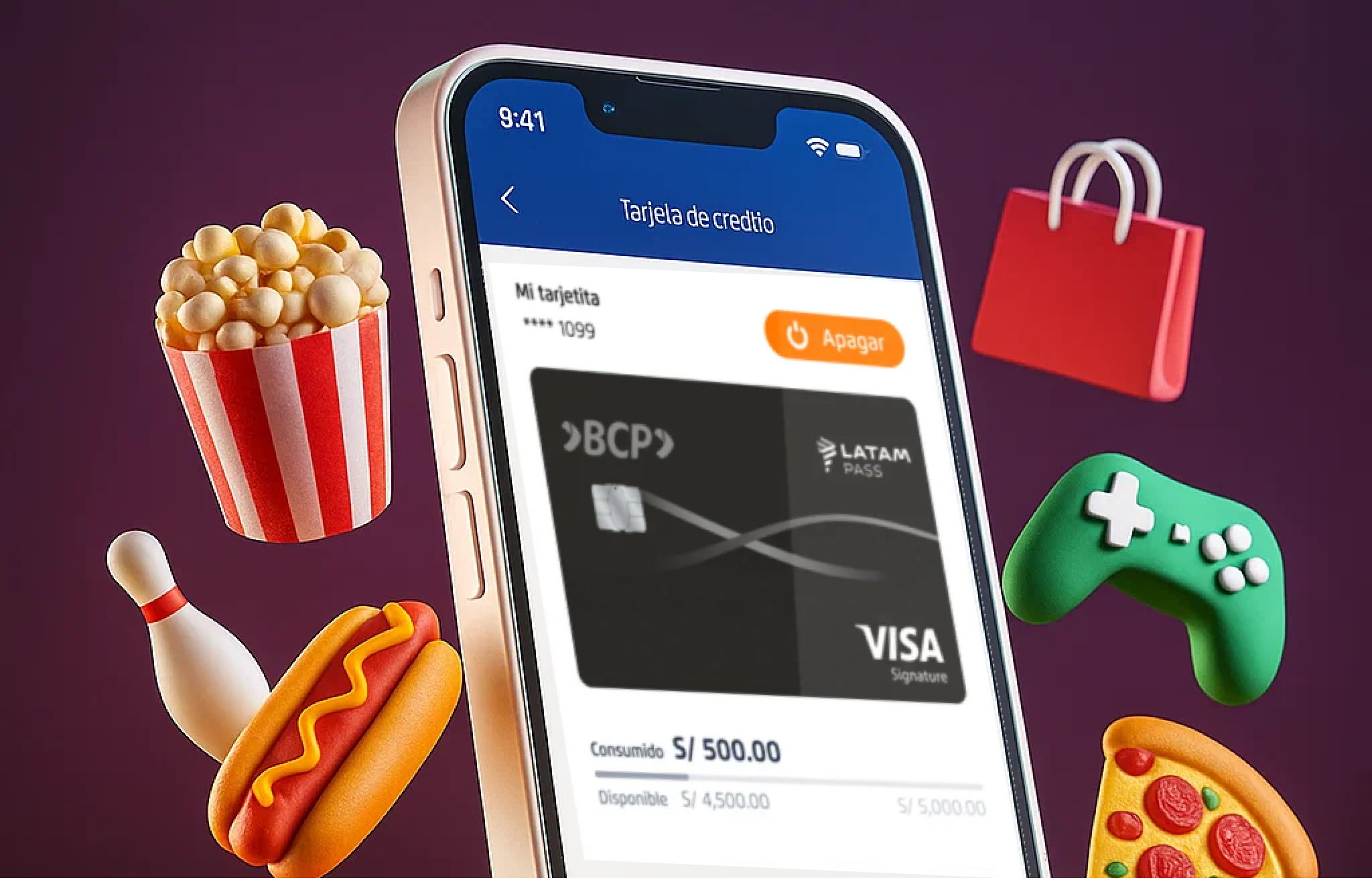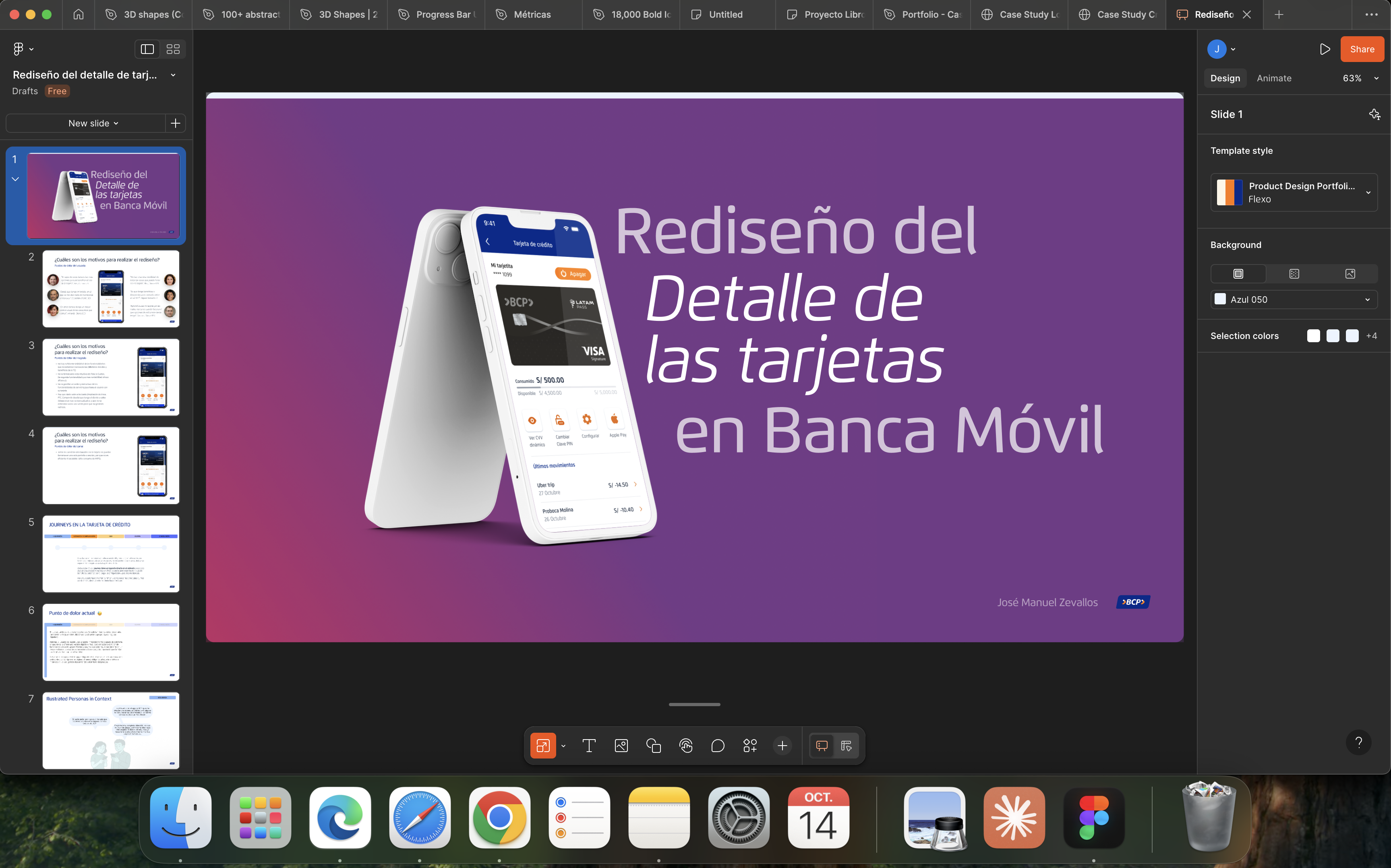2025
Redesigning a banking app to boost monthly engagement with credit card features by 60%
José Manuel Zevallos, Stanford University
Rol
Product Design
UI Design
Category
App mobile
iOS / Android
Project Type
Banking app
Redesign interface
Professional website of José Manuel Zevallos
Digital Media Designer © 2025. All rights reserved.
zevallosj147@gmail.com
LinkedIn: in/jmanuelzevallos

Challenge
The current process for requesting, activating, managing, and using cards within the banking app creates friction for users and leads to a high dependency on customer support channels. Functionality is scattered and poorly structured, negatively impacting adoption, early usage, and perceived product value. This affects both the customer experience and core business objectives.
Hypothesis
If the card experience were redesigned as a connected, guided, and scalable flow—integrating acquisition, activation, and initial usage—friction would be reduced, digital conversion would increase, customer satisfaction would improve, and operational load on the call center would decrease.
Summary
The project focused on redesigning the credit card experience within the banking app to improve visibility, structure, and usability. The goal was to create a cohesive and intuitive flow that connects acquisition, activation, and usage stages, enabling customers to better understand and manage their cards. This initiative sought to enhance user engagement, reduce friction, and drive a measurable impact on digital adoption and operational efficiency.
Problem Users Faced
Users found it difficult to locate and understand card-related functionalities, such as activation, limit management, or payment options. The experience felt fragmented and inconsistent, leading to confusion, distrust, and frequent reliance on customer service for basic operations. This lack of clarity directly affected product perception and overall satisfaction.
Business Objective
Increase digital adoption and card feature usage by 60% through a unified, user-centered experience that reduces support dependency and boosts self-service capabilities. The redesign aimed to align customer needs with business goals, improving retention, satisfaction (CES/NPS), and revenue from card operations.
Product Owner & Business Request
The Product Owner requested a strategic redesign to consolidate all card-related features into a single, seamless interface. The business expected the new experience to reduce call center volume, strengthen engagement with digital channels, and position the credit card as a key value driver within the app ecosystem.
Applied Methodology
To approach the redesign of the cards section in this banking app, I defined a custom methodological framework that combines elements from the Double Diamond, Design Thinking and Lean UX principles. This hybrid approach allowed me to address the challenge from a strategic, systemic, and outcome-driven perspective.
Preview of the presentation

This project is subject to confidentiality agreements due to my current work as a consultant, so the full process and results cannot be shared publicly.
However, I can elaborate on the methodological approach, the challenges addressed, and the strategic decisions made during a private conversation or interview.
2025
Redesigning a banking app to boost monthly engagement with credit card features by 60%
José Manuel Zevallos, Stanford University
Rol
Product Design
UI Design
Category
App mobile
iOS / Android
Project Type
Banking app
Redesign interface

Challenge
The current process for requesting, activating, managing, and using cards within the banking app creates friction for users and leads to a high dependency on customer support channels. Functionality is scattered and poorly structured, negatively impacting adoption, early usage, and perceived product value. This affects both the customer experience and core business objectives.
Hypothesis
If the card experience were redesigned as a connected, guided, and scalable flow—integrating acquisition, activation, and initial usage—friction would be reduced, digital conversion would increase, customer satisfaction would improve, and operational load on the call center would decrease.
Summary
The project focused on redesigning the credit card experience within the banking app to improve visibility, structure, and usability. The goal was to create a cohesive and intuitive flow that connects acquisition, activation, and usage stages, enabling customers to better understand and manage their cards. This initiative sought to enhance user engagement, reduce friction, and drive a measurable impact on digital adoption and operational efficiency.
Problem Users Faced
Users found it difficult to locate and understand card-related functionalities, such as activation, limit management, or payment options. The experience felt fragmented and inconsistent, leading to confusion, distrust, and frequent reliance on customer service for basic operations. This lack of clarity directly affected product perception and overall satisfaction.
Business Objective
Increase digital adoption and card feature usage by 60% through a unified, user-centered experience that reduces support dependency and boosts self-service capabilities. The redesign aimed to align customer needs with business goals, improving retention, satisfaction (CES/NPS), and revenue from card operations.
Product Owner & Business Request
The Product Owner requested a strategic redesign to consolidate all card-related features into a single, seamless interface. The business expected the new experience to reduce call center volume, strengthen engagement with digital channels, and position the credit card as a key value driver within the app ecosystem.
Applied Methodology
To approach the redesign of the cards section in this banking app, I defined a custom methodological framework that combines elements from the Double Diamond, Design Thinking and Lean UX principles. This hybrid approach allowed me to address the challenge from a strategic, systemic, and outcome-driven perspective.
Preview of the presentation

This project is subject to confidentiality agreements due to my current work as a consultant, so the full process and results cannot be shared publicly.
However, I can elaborate on the methodological approach, the challenges addressed, and the strategic decisions made during a private conversation or interview.
Professional website of José Manuel Zevallos
Digital Media Designer © 2025. All rights reserved.
zevallosj147@gmail.com
LinkedIn: in/jmanuelzevallos
2025
Redesigning a banking app to boost monthly engagement with credit card features by 60%
José Manuel Zevallos, Stanford University

Challenge
The current process for requesting, activating, managing, and using cards within the banking app creates friction for users and leads to a high dependency on customer support channels. Functionality is scattered and poorly structured, negatively impacting adoption, early usage, and perceived product value. This affects both the customer experience and core business objectives.
Hypothesis
If the card experience were redesigned as a connected, guided, and scalable flow—integrating acquisition, activation, and initial usage—friction would be reduced, digital conversion would increase, customer satisfaction would improve, and operational load on the call center would decrease.
Summary
The project focused on redesigning the credit card experience within the banking app to improve visibility, structure, and usability. The goal was to create a cohesive and intuitive flow that connects acquisition, activation, and usage stages, enabling customers to better understand and manage their cards. This initiative sought to enhance user engagement, reduce friction, and drive a measurable impact on digital adoption and operational efficiency.
Problem Users Faced
Users found it difficult to locate and understand card-related functionalities, such as activation, limit management, or payment options. The experience felt fragmented and inconsistent, leading to confusion, distrust, and frequent reliance on customer service for basic operations. This lack of clarity directly affected product perception and overall satisfaction.
Business Objective
Increase digital adoption and card feature usage by 60% through a unified, user-centered experience that reduces support dependency and boosts self-service capabilities. The redesign aimed to align customer needs with business goals, improving retention, satisfaction (CES/NPS), and revenue from card operations.
Product Owner & Business Request
The Product Owner requested a strategic redesign to consolidate all card-related features into a single, seamless interface. The business expected the new experience to reduce call center volume, strengthen engagement with digital channels, and position the credit card as a key value driver within the app ecosystem.
Applied Methodology
To approach the redesign of the cards section in this banking app, I defined a custom methodological framework that combines elements from the Double Diamond, Design Thinking and Lean UX principles. This hybrid approach allowed me to address the challenge from a strategic, systemic, and outcome-driven perspective.
Preview of the presentation

This project is subject to confidentiality agreements due to my current work as a consultant, so the full process and results cannot be shared publicly.
However, I can elaborate on the methodological approach, the challenges addressed, and the strategic decisions made during a private conversation or interview.
Rol
Product Design
UI Design
Category
App mobile
iOS / Android
Project Type
Banking app
Redesign interface
Professional website of José Manuel Zevallos
Digital Media Designer © 2025. All rights reserved.
zevallosj147@gmail.com
LinkedIn: in/jmanuelzevallos
